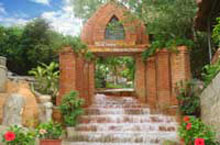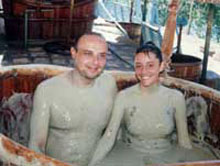Ha Nguyen takes a paid holiday to beautiful resorts where customers are pampered round the clock and come away healthier than ever.
An increasing number of people are combining tourism with the advantages of natural medicine.

Some of Vietnam’s most popular tourist sites offer added health benefits; the Thap Ba Hot Springs in the central coastal city of Nha Trang, the Kim Boi Mineral Waters In the north-western province of Hoa Binh and the National Institute of Acupuncture in Hanoi are all places where visitors can enjoy traditional therapies.
An American-Vietnamese visitor, Duong Quang Phong, says he is going to bring his family and his 72-year old mother to the Thap Ba Hot Springs for the second time over this year’s Tet holiday.
"We were all interested in the health tour we made to the site in 2006. After two weeks my mother’s health was much better, but more importantly, she completely recovered from her skin disease," Phong says, adding that his wife really enjoyed soaking herself in the mineral water.
The idea of bogging down in the mud or soaking in hot spring water for relaxation and health is a new concept in Vietnam, but is quickly gaining popularity.
"In addition to being relaxing and stimulating the nervous system, the hot spring water and mineral mud can cure skin diseases and make the skin white and soft," says Phong’s mother Tran Thi Dy.
Stress release
In addition to lounging on the beach and enjoying the night life, Nha Trang offers one activity that is not to be missed: a mud bath at the Thap Ba Hot Spring Centre.
To reach the centre, located just 4 km from downtown Nha Trang, visitors take the road that passes the Ponagar Cham Towers. Just down the road, the spa sits perched on a hillside, overlooking the river, says Phong.
Although the secluded spa, which can accommodate 400 customers an hour, offers only basic amenities, it is becoming increasingly popular and visitors may find it crowded with both locals and foreigners.
"We were advised to first soak in hot mineral water for 45 minutes," says Phong. For that purpose, 25 pools with underwater massage taps are situated on the slope of the hill. To get the full effect of the treatment, visitors should take break every 5 minutes and rest on the side of the pool. The mineral water is kept at 38-41oC and is changed between customers.
After the mineral water, visitors can soak in an outdoor mud bath. There are two options – private or communal mud bathing. The private bath can accommodate two people and a bamboo screen protects visitors’ privacy. Up to eight people can splash about in the communal bath, which is less expensive and livelier.
The mud, which comes from a natural source 60 km away, is heated to 37-38oC. Towels and even bathing costumes are supplied. Plans for a mud lake for public bathing are in the works.
After soaking in the mud for 15-20 minutes, visitors can dry off in the sun or get a relaxing massage. For die-hard swimmers, there is a larger, warm mineral swimming pool, says Phong.
For those who want a quiet, private experience, the centre has opened a 14-room VIP area with a sauna, a Jacuzzi and massage services. A hairdresser is on-call and fresh fruit is available to guests in their private rooms, Phong says.
A soak in the mud costs VND 50,000 -150,000 for an adult, depending on the type of mud. Use of the hot mineral pool costs VND 50,000 per person. A VIP single room is USD 105 and a double room is USD 145.
The director of the Thap Ba Hot Spring Centre, Hoang Quang, told Vietnam News that despite the fact that natural medicinal tourism is new to the country, his centre has received nearly 400,000 travelers this year, up 5 per cent against the same period last year, including 30,629 foreign tourists by October, up 10 per cent from the same period last year.
"Many people, particularly those with skin ailments or a lot of stress, are cured after enjoying health tourism at the Thap Ba site," says Quang.

Vietnam has abundant natural resources to provide natural medicine for the health tourism industry, especially hot springs and mineral water sites, so local people should not have to travel far to get treatment for long-term skin ailments, he advises. Nha Trang City received 1 million tourists in the first six months of this year, 29 per cent higher than last year, and the tourism industry raked in VND 800 billion (USD 47.6 million) this year, 40 per cent higher than the same period last year.
Kim Boi hot springs
A 30 km drive from the town of Hoa Binh will lead visitors to the Kim Boi guest house. The house was built near the site of a large mineral pool and the sound of rushing water can be heard while sitting inside. Scientific tests have shown that the mineral water at Kim Boi, which is a constant 36oC, is suitable for drinking, bathing and for the treatment of rheumatism, intestinal diseases, stomach-aches and high blood pressure.
Le Thi Hai, from the northern province of Hai Duong, says her family visits the mineral waters every year.
"It’s very good for my rheumatism as well as for my mother’s hypertension. The prices are affordable," she says.
Dinh Thi Phien, director of the Hoa Binh Traditional Herbal Company, says the company has added to the Kim Boi site, opening a new centre for relaxation in Phong Thu Commune, Cao Phong District.
"We are preserving more than 200 rare traditional herbs from ethnic groups, a valuable herbal treatment resource," says Phien, adding that for travelers, who are interested in the herbal treatments, the centre offers acupuncture, pressure point massage and herbal bathes. The prices range from VND 200,000 - 300,000 a day per person.
Naturopathy tourism brought Asian countries, including India, Thailand and Singapore, USD 1.6 billion last year, but it is still a new industry in Vietnam. The country’s health facilities and services are as not as modern as other countries, according to figures from the Vietnam National Administration of Tourism (VNAT).
However, Vietnam is known worldwide for its traditional herbal medicine. "It’s a potential source for us to tap and develop health tourism," an official from VNAT says. The National Institute of Acupuncture in Hanoi is internationally recognized and more affordable than similar institutions in countries like Thailand and Singapore.
"Hanoi is a big site for health tourism for herbal treatments, particularly acupuncture. I hope it will become a good destination for health tourism in the future," says Mai Tien Dung, deputy director of the Hanoi Department of Culture, Sports and Tourism.
Seeking tourists
Vietnam’s tourism sector is anticipating an average of 7-8 million foreign visitors a year for the next 10 years, but is still struggling to create an image which will increase those figures.
In the first seven months of the year, the sector’s growth rate was a steady 10.6 per cent, well under the industry’s target rate of 19 per cent. Nguyen Van Binh, of the VNAT, says that worldwide inflation led to the disappointing figures.
One solution is to enhance advertising in key markets and give priority to building a brand name for national tourism, says Binh.
Yip Hoong-mun, deputy managing director of Capital Land Vietnam Holdings, says that Vietnam has a lot of potential to develop its tourism industry, but is still a ‘hidden charm’, adding that it is time for the nation to develop strategies to bring Vietnam into the international community.
Industry experts have expressed that Vietnam is in need of a clear message to convey its attractions to potential tourists.
VNAT’s development strategy aims to turn the country into one of the world’s top destinations by 2010.
Tran Chien Thang, deputy minister of Culture, Sports and Tourism, says that the sector plans to advertise Viet Nam on international television networks as well as in newspapers in Singapore, Malaysia, Thailand and Cambodia.
Despite these efforts, the sector has yet to identify strategic tourism products in its advertising campaigns, say VNAT officers. The cultural and eco-tourism aspects of the advertising campaign, which are considered Vietnam’s strengths, have appeared vague and are not memorable to visitors.
Even if they are successful in attracting visitors, travel companies will still be hard-pressed to meet visitors’ demands if the infrastructure is not improved.
Though Vietnam’s tourism sector has some kinks to work out, the country still expects to lure around 6 million foreign visitors in 2010, according to statistics released by the Tourism Association.